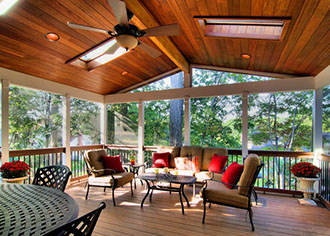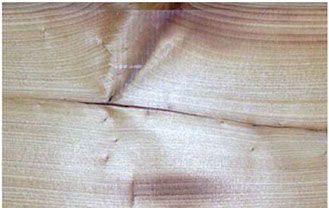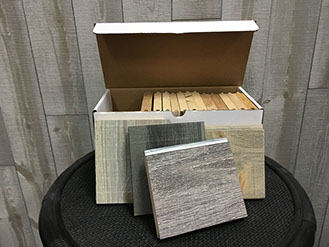WHAT TO EXPECT
RESOURCES
WHAT CAN I EXPECT FROM SYNERGY WOOD?
 We use real wood for all of our products. Our various species of wood come from the best lumber mills across the United States and include Red Grandis, Eastern White Pine and Southern Pine.
We use real wood for all of our products. Our various species of wood come from the best lumber mills across the United States and include Red Grandis, Eastern White Pine and Southern Pine.
Natural variations in the wood, which can include knot structure, grain color, and grain patterns, should be expected and is where the beauty of real wood comes from. These variations in the wood are the reason real wood is chosen to beautify a home.
GRADING OF LUMBER
Even though each type of wood has it's own grading system, the purpose of grading lumber is the same; a method to communicate between buyer and seller of what is and isn’t acceptable.
Boards are first graded at the lumber mill using standardized grading. During our production process, we re-inspect, re-grade and select each board by hand. Even with this extra grading, wood is a natural product and therefore, each piece is going to be uniquely different. The result of Synergy's extra grading process is an "easy to install" product that is 99% usable and reduces on-site installation waste from 30% to 5% or less.
Every board that is delivered to a job site is usable. A guide to Synergy Grading is available. Visit the page “How To Use What’s Delivered”.
WHAT SYNERGY ALLOWS
Synergy grades each piece of lumber based on accepted industry grading rules, there are other things we look at, such as side bend and checks.
 A check is a lengthwise separation of the wood, which occurs usually across the rings of annual growth. The photo shows a check on a plank of cypress.
A check is a lengthwise separation of the wood, which occurs usually across the rings of annual growth. The photo shows a check on a plank of cypress.
A side bent board is a board that when laid flat, there is a slight curve in the axial direction. A diagram of this is shown on our website “How To Use What’s Delivered”.
Synergy allows the following during our manufacturing process (based on length to curve):
- 4’ to 7’ boards; up to 1/4” side bend
- 7.1/2’ to 8’ boards; up to 3/8” side bend
- 9.1/2’ to 10’ boards; up to 1/2” side bend
- 11.1/2’ boards; up to 5/8” side bend
- 12’ to 14’ boards; up to 3/4” side bend
THE SYNERGY PROCESS
Tongue and Groove
The first step in producing our Synergy Collection tongue and groove products is to run the raw wood through our molder. This puts the tongue and groove (T&G) profile on the long edge of each board. All Synergy Wood products have a face width tolerance of 1/16".
T&G with End Matching
 The wood is then hand-sorted and inspected for any objectionable defects such as holes, splits, cracks, loose or missing knots. The visible defects are removed and then each piece is end matched with a male/female interlocking end.
The wood is then hand-sorted and inspected for any objectionable defects such as holes, splits, cracks, loose or missing knots. The visible defects are removed and then each piece is end matched with a male/female interlocking end.
Sanding. Sanding. Sanding.
After the end matching process, the board is sanded in multiple steps - making them ready for the staining process.
One of the reasons for all of this sanding is to remove “chatter” marks on the boards from the molding operation. Chatter marks are horizontal lines on the board caused by the knives of the molder cutting the board while it is being run through the molder. These lines will not come out of the board without the multiple sanding process. If the chatter is not removed, it will show up more once the stain is put on the board. If you use raw t&g from a lumber yard - and stain on location - you have experienced this first hand!
Hand Wiped Stain
Unlike other companies or on-site installers, we hand-wipe each piece of wood after the stain is applied which “pushes” the stain deeper into the wood. The result is a deeper, consistent color that cannot be achieved on-site.
Sign Sealed Delivered...
After our hand-stained boards go through our thorough drying process, a clear sealer coat of an exterior grade polyurethane is applied. The sealer coat is designed to envelop the porous wood (which includes the stained portion of the wood), preventing the next coat of polyurethane from being excessively absorbed into the wood. Upon completion of a second drying cycle, the wood is lightly sanded and is now ready for the final coat of exterior grade polyurethane.
Our customers choose Synergy because our artisans create a handcrafted wood board that is naturally beautiful, exceptionally durable and easy to install. Synergy does all the painstaking, time-consuming steps so that you get a "ready to install" product that reduces labor and waste.
SYNERGY SAMPLES
 To really appreciate the true color and feel of real wood, you need Synergy Wood sample boxes. To get free solid wood color samples, click here!
To really appreciate the true color and feel of real wood, you need Synergy Wood sample boxes. To get free solid wood color samples, click here!
If you have received a sample of one of our cypress or pine products, please note that all of our samples are cut from #2 mill-graded lumber. Most of our samples may not have knots in them and this is NOT common of our #2 graded products, which will have knots present. Please keep that in mind when making your purchase.
COLOR VARIATION
Wood is a natural product and when stained, natural variations in color and grain pattern are to be expected. On some woods, including but not limited to, Ponderosa Pine, heartwood is naturally present and is visible through all colors. Over time, the heartwood will “age” or darken when exposed to any source of light. Depending on the color, this may produce a yellowish or reddish streak in the wood.
5 YEAR WARRANTY
Our Rustic Collection is designed for interior use only. Our Synergy and E-Peck Collection are designed for interior wall and ceiling and exterior ceiling applications - we do not recommend or warranty any Synergy Wood product that has been exposed to direct sunlight or direct moisture. Click here for more information on our 5-year limited warranty.
In the unlikely event of a warranty claim, the end-user is responsible for documenting the Job Number and Manufacture Date of the product being used. This information can be found on each of the packages being delivered to the job site. No claims can be made without this information.
Over time, we have observed that it is very easy (defined as light pressure applied to the board when placed on edge) to “straighten” a board with side bend with the given dimensions above. Of course, if a side bend board is found while installing and it is undesirable, it can still be used. Synergy has provided a guide called, How To Use What’s Delivered.
Chipped grain means that a part of the surface is chipped or broken out in very short particles below the line of cut. It should not be classed as torn grain and, as usually found, shall not be considered a defect unless it is present more than 25% of the area.
Loosened grain means that a small portion of the wood has become loosened but not displaced.
Torn grain means that a part of the wood is torn out in dressing, and in-depth is four distinct characters; slight, medium, heavy and deep.
The medium torn grain is over 1/32”, but not more than 1/16” in depth.
Skip is an area on a piece that failed to surface. A heavy skip is one that the planer knife did not touch.
Machine burn is a darkening or charring of the wood due to overheating by the machine knives.
Machine gouge is a grooving across a piece due to the machine cutting below the desired line of cut.
A sound knot is solid across its face, as hard as the surrounding wood, and shows no indication of decay.
A medium knot is one over 3/4”, but not more than 1.1/2” in diameter.
A pith knot is a sound knot with a soft center not more than 1/4” in diameter.
Peck is decay which appears in the form of a hole, pocket, or area of soft rot usually surrounded by sound wood. Slight peck is not through the piece occupying less than 10% of the surface area.
Decay is a disintegration of the wood substance due to the action of wood-destroying fungi and is also known as dote or rot.
Machine bite is a depressed cut of the machine knives at the end of the piece.
A shake is a lengthwise separation of the wood, which occurs usually between and parallel to the rings of annual growth.
A check is a lengthwise separation of the wood, which occurs usually across the rings of annual growth.
Wane is bark, or the lack of wood or bark, from any cause on the edge or corner of a piece.
Pith is the small soft core in the structural center of the log.
Pitch is an accumulation of resinous material.
Need more information? Contact us at info@synergywood.com or call direct at 866-791-6714.
GET SAMPLES

Our Central Florida showroom is open M - F from 8am - 4pm.
3031 S Mellonville Ave 866.791.6714
Sanford, Florida 32773 info@synergywood.com
© 2023 Synergy Wood®. All Rights Reserved. Synergy Wood®, E-Peck® and the "S" logo mark are all registered trade marks of Synergy Wood Products, Inc.